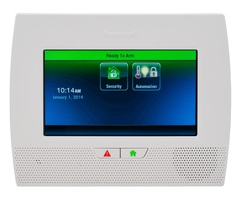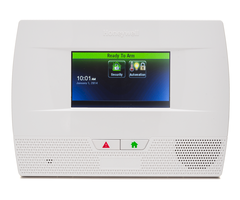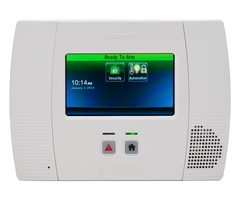Using the Lynx Touch with a 3rd Party Z-Wave Controller
Related Products



Related Categories
Description
In this video, Joe explains how you can use a Honeywell LYNX Touch Panel as a secondary Z-Wave controller. This is done by pairing the Lynx Touch System with a primary Z-Wave controller. Every Z-Wave device that is used with the primary controller will be automatically pushed over to the LYNX Panel.
The advantage to making the LYNX Touch a secondary Z-Wave controller is that you won't need to choose which Z-Wave network to use when enrolling a new Z-Wave device. Remember, each Z-Wave device can only be paired with one Z-Wave network at any given time. By setting up a LYNX as a secondary Z-Wave controller, you can keep all your Z-Wave devices organized on one single network. This makes things much easier to understand.
When you make the LYNX Touch a secondary controller, all of the devices from the primary controller will be pushed over to the LYNX. This way, you can control them from the LYNX and the primary controller. Additionally, Total Connect 2.0 still allows remote automation and control when the panel is set up as a secondary Z-Wave controller. In other words, you will still be able to execute automation commands from TC2 and perform smart scenes.
One thing to note when making the LYNX a secondary Z-Wave controller is that you will no longer be able to learn-in new Z-Wave devices with the LYNX Touch. Instead, you will need to enroll all new Z-Wave devices with the primary controller. You must sync the LYNX with the primary controller in order for any new Z-Wave device to be enrolled with the Z-Wave network.
Remember, you can only use Z-Wave functionality with a LYNX Touch if an L5100-ZWAVE Card has been installed the system. This module serves as the Z-Wave controller for the system. None of the Lynx Touch Systems come with a Z-Wave controller by default. The L5100-ZWAVE must be added and installed separately.
http://alrm.gd/get-monitored
Transcript
Hi, DIYers. Joe from AlarmGrid. And today we're going to talk about using the LYNX Touch Panel as a secondary controller in a Z-Wave network. Now, there's a few instances where you might want to do this. And let's actually go over what it is in the first place. So with using the L7000 as an example, the LYNX Touch Panels, many of them, can have a Z-Wave module installed inside of them which will allow you to control Z-Wave devices that you connect to the system. These devices are stuff like light switches, door locks, and other automation devices. Now, there's a whole bunch of things out there right now that do and act as Z-Wave controllers. And you may have one of these in your home. Now, as you may know, Z-Wave devices, they can only be directly connected to one Z-Wave controller. So let's say you have something like a Samsung SmartThings installed in your house, and you have a bunch of lights connected to that. And then, for whatever reason, you get a Lynx Touch Panel, and you also have a Z-Wave controller inside of this. When you get this installed, if you don't use it as a secondary controller, you would have to pick which controller you add a light switch to, which can get messy and really annoying. For example, let's say you have a front door light that you have connected to your Samsung SmartThings and it's in scenes and rules, so it works based on certain things. You'll probably also going to want that connected to the LYNX Panel, so that based on alarm conditions, you can have the light turn on and off. In the event where you don't have it as a secondary controller, you would actually have to remove it from the Samsung SmartThings and add it to the LYNX Panel. Now you're going to be in the situation where you're going around the house and you're figuring out which device you want on which controller, which isn't practical. And it's going to get really frustrating. What the secondary controller function is going to allow you to do is when you enroll the LYNX as a secondary controller to the Samsung SmartThings, or whatever other Z-Wave controller you have, it's going to see the same automation devices, and it will be able to control them. The downside is that you're not going to be able to learn Z-Wave devices into the secondary directly. It's going to pull it from the primary controller. So what we're going to do is we're going to go to the Samsung SmartThing app, just to show that we do have a Z-Wave device programmed to the Samsung SmartThings. So on the tablet, I'm going to click on SmartThings. And I'm going to go to My Home. And as you can see, there's a Z-Wave dimmer right there under Things. This isn't currently programmed into our LYNX Touch Panel. And when we add the LYNX Touch Panel as a secondary controller, it's actually going to pull it over. So if we go to our LYNX controller, or our LYNX panel, click on Automation. When I click on Switches, you can see that there's no switches that are currently enrolled-- UA switches, that is. What I'm going to do is go back and press the down arrow, click on Tools, and then do Advanced Tools. Enter the installer code, 4-1-1-2. And we're going to wait on this screen while we put the SmartThings into the enrollment mode. So on our SmartThings, I'm going to click on the Add a Thing button. Now it's looking for devices. What we have to do on our LYNX Panel is click on Learn. Now, this may take a moment, so be patient. And as you can see, it's [NO AUDIO] In our SmartThing app, we can see that the Z-Wave controller is showing up, which is the LYNX Panel. And when we see that, we click Save. It's going to say, Confirm Pair Devices. Go ahead and click OK. And in our app, we see that the Z-Wave controller has shown up. On the LYNX Panel, you're going to have to wait until this screen completes its process. Once it says Done, you can click OK. Then if we go back and we click on Switches again, we'll see that that switch that is enrolled to the SmartThings hub is now showing up on our LYNX Panel. Now, one of the benefits to using a LYNX Touch as a secondary controller, as compared to a VAM or a Tuxedo Touch, is that when it's acting as a secondary controller, you'll still be able to control these Z-Wave devices in the Z-Wave network through Total Connect 2.0. If you have a Tuxedo Touch or a VAM working as a secondary controller, the Z-Wave devices that are connected on that Z-Wave network, you won't be able to access those through Total Connect. So just to show you this as an example, I'm going to log into Total Connect 2.0 on the iPad and show you that I can still see the switch that we enrolled. So I'm going to click on Total Connect 2.0. As you can see, I'm already logged in. If I go to Automation, you'll see that the switch is able to be interacted with, even though the L7000 is working as a secondary controller with the SmartThings hub. That's how to add the LYNX Touch System as a secondary controller on a Z-Wave network to an existing hub. If you have any questions about this process, as it can be kind of confusing, feel free to give us a call at 888-818-7728, send us an email to support@alarmgrid.com, or head to our website www.alarmgrid.com. If you enjoyed the video, feel free to subscribe. And if you want to be notified when we post future videos, hit the notification button below, and we'll send you an update when we do so. Thanks for watching, and have a good day.
- Uploaded

